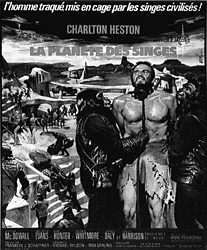

In honor of IFS's screening of "Planet of the Apes", the Review's Benjamin Clark collected his feelings on this truly American film.
Planet of the Apes is one of those movies you pass by on late night television for a "CHiPs" rerun, or the latest food-dehydration infomercial. Few take the time to break through the stigma attached to this movie and realize its cinematic value. Underneath the buckets of latex and over-the-top acting, lies great social commentary, portraying a volatile period in American history.
20th Century Fox released Planet of the Apes in 1968 amidst the Cold War, the Civil Rights Movement and space exploration. The film reflects these elements with a sharp portrayal of racial classes and apocalyptic visions.
Charleton Heston stars in this epic, supported by the notable Kim Hunter and Roddy McDowell. Cloaked in a chimpanzee costume, it is impossible to recognize her, but Hunter also starred in A Streetcar Named Desire, as Stella Kowalski, earning the best supporting actress Academy Award for her performance. Heston by this point had already gained his screen icon status. Rod Serling of The Twilight Zone fame shares writing credit on the film with Michael Wilson. Finally, Franklin J. Schaffner, who also directed Patton, directed this masterpiece.
So where the does the value lie in this classic tale of ape culture? The ending supplies a striking conclusion to the story. For those who have not seen Planet of the Apes, I will not give it away, but the final image that ties the film together is startling, both to the characters and to the audience.

Schaffner's depiction of the ape culture is one of the better aspects of the film. There are three classes of monkeys: gorillas, chimpanzees and orangutans. The dark, violent gorillas makeup the warrior class. The lighter-skinned chimpanzees are sort of the middle-class, student types, and the fairer orangutans form the ruling intelligentsia. Shaffner's portrayal comes off as a sizzling satire of 1960s racial politics.
Planet of the Apes opens with four astronauts jetting through space in a shuttle that looks about as sophisticated as the forts I used to build with my sofa cushions. The astronauts tuck themselves in for a "hibernation sleep," a sleep that keeps them from aging while their vessel plunges into the depths of space. The astronauts are awoken when their ship crashes on a rocky, arid planet and the space cadets trample out of the ship looking for life forms. They happen across a band of savage, mute white-people running around in leather bikinis and loincloths. Without provocation, horse-riding gorilla warriors capture the astronauts and the savages. One of the astronauts, played by Heston, survives the brutal roundup and spends the rest of the film trying to convince members of the civilized primate culture that he is an intelligent space man from the planet.
On the surface the plot is pretty humorous. The dated makeup and costumes look pretty weak by today's standards. Considering 2001: A Space Odyssey was also released in 1968, the special effects are flimsy. Heston runs around in a loincloth for most of the film, looking not too shabby for a 44-year-old. His performance, however, is less than biblical. Four sequels (Beneath the Planet of the Apes, Battle for the Planet of the Apes, Conquest of the Planet of the Apes, Escape from the Planet of the Apes) and a short-lived television series helped to form the poor image that surrounds this film.
Planet of the Apes serves as a superb example of highbrow science fiction, with insightful perspectives on American society in the 1960s.
International apes: The film's fame was not just limited to the U.S., as shown by this original advertising poster for the film's release in France.
Copyright © 1999, The Oberlin Review.
Volume 128, Number 5, October 1, 1999
Contact us with your comments and suggestions.